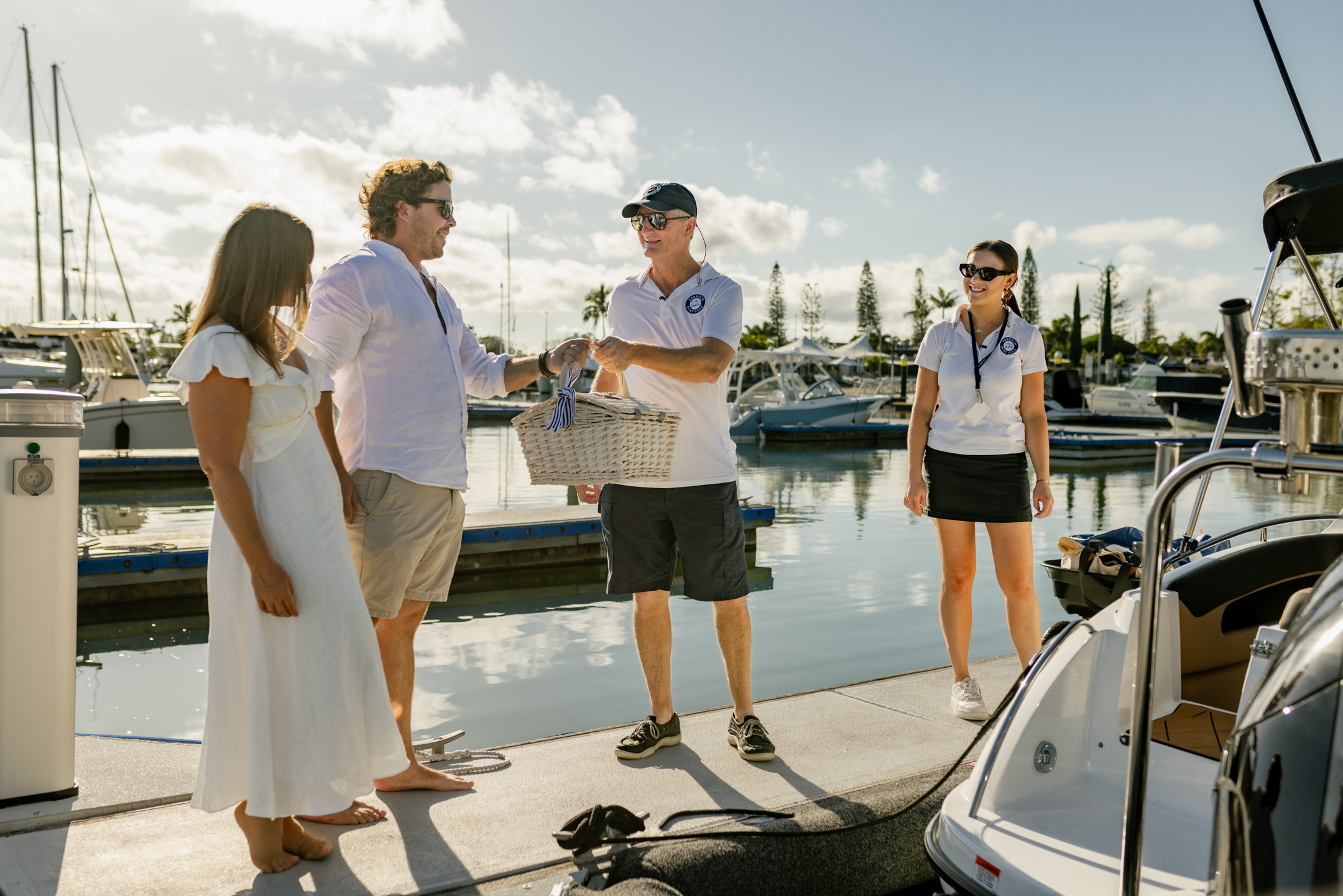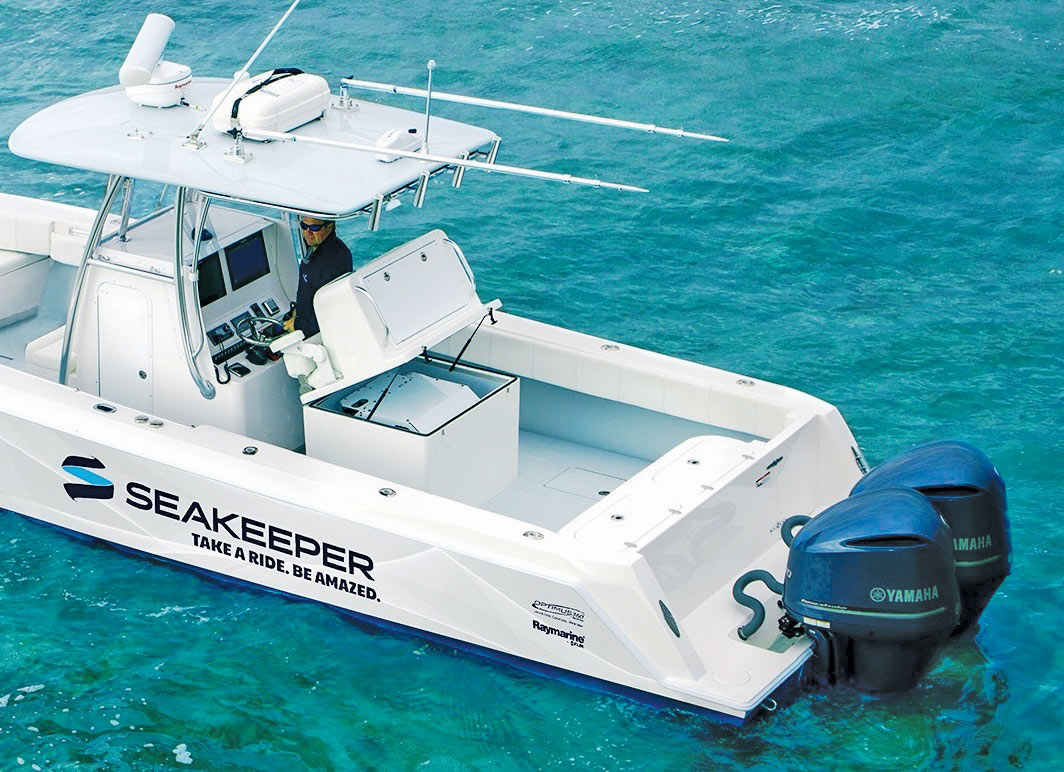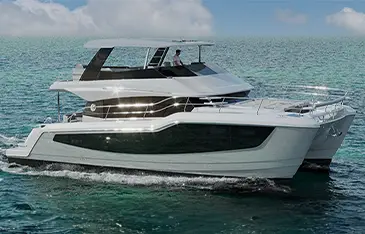Storage on a Boat: Useful Tips and Space-Saving Solutions
Boat storage is an essential aspect of owning a vessel, as maximizing the limited available space on board can significantly enhance your boating experience. An efficient storage system not only makes it easier to navigate around the boat but also keeps valuables and necessities organized and secure. This article will discuss the importance of understanding boat storage, the considerations involved in selecting appropriate storage solutions, and offer tips for maintaining optimal organization on board.
Storage on a boat can vary depending on the type of vessel, its size, and intended use. Crafting a proper storage plan involves considering factors such as security measures, the need to preserve items during storage, and integrating organization solutions that cater to the unique layout and design of the boat. Ultimately, the goal is to create a storage system that allows for maximum utilization of the available space, and ensures the accessibility and functionality of the boat at all times.

Key Takeaways
- Establishing an efficient storage system on a boat improves organization, navigation, and overall experience.
- Security measures, preserving items, and organization solutions should be considered when selecting storage options.
- Storage plans must be tailored to the unique design, size, and intended use of the boat to ensure optimal functionality.
Understanding Boat Storage
Boat storage is an essential aspect of boat ownership that ensures the longevity and proper maintenance of your vessel. There are several options for storing your boat, depending on your needs, budget, and location. In this section, we will discuss various types of boat storage, including outdoor boat storage, indoor boat storage, winter boat storage, cheap boat storage, covered storage, and extra space storage.
Outdoor Boat Storage
Outdoor boat storage is a popular option for many boat owners due to its affordability and accessibility. Typically, boat owners store their vessels in outdoor storage facilities, marinas, or even on their property. One advantage of outdoor storage is the ease of access to the water, especially if stored at a marina. However, it's important to note that boats stored outdoors are exposed to the elements, such as sun, wind, and rain, which may necessitate additional maintenance.

Indoor Boat Storage
Indoor boat storage provides a more controlled environment for your vessel, protecting it from weather-related damage. Whether it's a storage unit or a dedicated boat storage facility, indoor storage keeps the boat shielded from the elements, reducing the need for frequent cleaning and maintenance. However, indoor storage options can be more expensive than outdoor options and may have limited availability based on the size of your boat.
Winter Boat Storage
Winter boat storage is crucial for boat owners in colder climates, as it protects your vessel from freezing temperatures and potential damage caused by ice and snow. Winterizing your boat and storing it in a suitable location is essential for maintaining its lifespan. Options for winter boat storage include heated indoor storage facilities and shrink-wrapping the boat prior to storing it outdoors.

Cheap Boat Storage
For boat owners on a budget, cheap boat storage options are available. Outdoor storage options, such as storing your boat on your property or at a less-expensive marina, may be more cost-effective. However, these options might provide less protection from the elements, so it's essential to balance cost and protection to ensure the boat's longevity.
Covered Storage
Covered storage is a middle ground between outdoor and indoor boat storage. This type of storage offers a roof or canopy-like structure that protects your boat from direct sunlight, rain, and snow while still being stored outdoors. Covered storage is often more affordable than indoor storage and provides better protection than uncovered outdoor storage.
Extra Space Storage
Extra space storage refers to facilities that offer additional storage space for boat owners who need room for gear, equipment, or even multiple watercraft. These facilities might offer options such as storage units, boat racks, or additional dock space to accommodate your needs. This type of storage is particularly beneficial for boat owners with numerous watercraft or large recreational equipment that requires safekeeping.
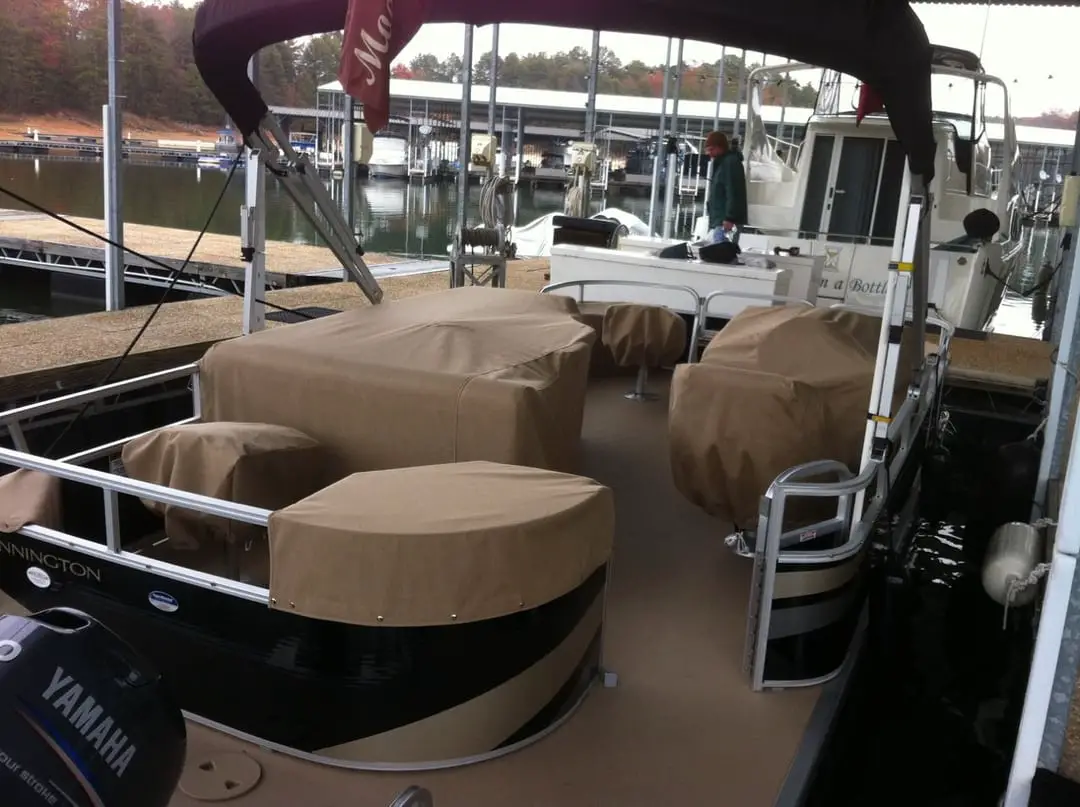
Security Measures for Boat Storage
When it comes to boat storage, ensuring security is paramount for both the vessel and the valuables inside. This section will discuss important security measures including marina safety and custom storage security.
Marina Safety
Selecting a marina with strong security measures in place can help protect your boat from potential theft and vandalism. When considering a marina for storage, look for the following features:
- Secure Access: The marina should have controlled access points, such as gates or doors, that require a key, card, or code to enter.
- Surveillance: Look for a marina with a comprehensive security camera system covering the main entrance, docks, and storage areas. This will help deter potential thieves and provide evidence in case of theft or vandalism.
- Lighting: Well-lit areas can act as a deterrent for would-be criminals, so ensure that the marina has adequate lighting throughout its grounds, especially in high-traffic areas.
- Security Personnel: A marina with on-site security staff can provide an additional layer of protection for your boat, and they may offer regular patrols of the premises.
- Emergency Equipment: Check if the marina has fire safety measures as discussed in this study and other emergency equipment on hand, such as life rafts and communication devices, in case of an incident.

Custom Storage Security
Even with the security measures in place at a marina, boat owners can take additional steps to protect their vessel and belongings by implementing custom storage security features on their boat. Some suggestions include:
- Lockable Storage Compartments: Installing lockable storage compartments and closets can help keep valuable items, like electronics and fishing equipment, secure while the boat is stored in the marina.
- Alarm System: Installing a boat-specific alarm system, similar to a home or car security system, can provide an added layer of protection against break-ins or theft.
- Tracking Device: A GPS tracking device can be installed on the boat, allowing you to monitor its location in real-time. In the event of a theft, this can help law enforcement quickly locate and recover your vessel.
- Marine Locks: Use marine-specific locks and cables to secure the boat itself, as well as any small watercraft, such as kayaks or paddleboards, that may be stored on the boat. These locks are designed to withstand harsh marine conditions.
By implementing these marina safety measures and custom storage security enhancements, boat owners can help ensure the security of their vessels while stored at the marina. Remember, a combination of both marina and custom storage security features is vital for optimal protection.

Preparing Your Boat for Storage
Storing a boat is more than just finding a place to park it. Proper care and preparation are essential for ensuring your boat's long life and optimal performance. There are two crucial aspects of boat storage that need to be addressed: winterizing your boat and shrink-wrapping your boat.
Winterizing Your Boat
Winterizing your boat is an essential process for those living in colder climates. Cold temperatures and ice can be damaging to your boat's components and cause significant wear and tear. To winterize your boat, follow these steps:
- Drain water: Remove any water from the boat's bilge and plumbing system, as freezing water can cause damage to the pipes and other components.
- Fuel treatment: Add a fuel stabilizer to the fuel tank to prevent condensation and fuel degradation.
- Engine care: Change the engine oil and replace the filter to ensure smooth performance for the following season. Also, flush the cooling system and apply anti-freeze as necessary.
- Battery storage: Disconnect the battery and store it in a dry, cool place where it won't be exposed to extreme temperatures.
- Interior care: Clean the boat's interior surfaces and remove any moisture to prevent mold and mildew growth during storage.
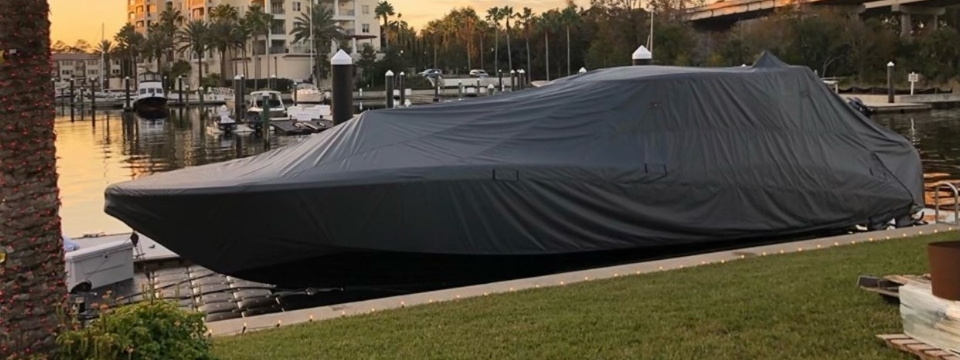
Shrink-Wrapping Your Boat
Shrink-wrapping your boat is another essential step for boat storage. A shrink-wrapped cover will help protect your boat from weather-related damage, such as UV rays, wind, rain, snow, and ice. To shrink-wrap your boat, you can follow these steps:
- Clean the boat: Give your boat a thorough cleaning to remove dirt and debris from the exterior.
- Remove sharp objects: Ensure all sharp objects and protrusions that could potentially puncture the shrink-wrap are covered or removed.
- Build a frame: Construct a supportive frame, typically using wooden or PVC materials, to provide support for the shrink-wrap and to allow for proper ventilation and moisture prevention during storage.
- Apply the shrink-wrap: Starting at the bow, unroll the shrink wrap material and work your way down to the stern, ensuring that it covers the entire boat. Secure the material with strapping or rope.
- Heat the wrap: Using a specialized propane heat gun, apply heat to the shrink-wrap material in a sweeping motion, being careful not to overheat or burn the material.
By winterizing and shrink-wrapping your boat, you can ensure it is protected and preserved during storage, minimizing potential damage and extending its life. Remember to always follow proper safety protocols and consult with professionals if you're unsure about any aspects of preparing your boat for storage.

Boat Design and Storage
When it comes to boat design, proper storage solutions are essential for ensuring functionality, safety, and efficiency. This section addresses two critical aspects of storage on a boat—storage space design and boat lift design.
Storage Space Design
Effective storage space design is crucial in making the most of the limited space available on a boat while maintaining its stability in the water. To achieve this, it is important to consider the following factors:
- Location: Storage areas should be distributed evenly throughout the boat to maintain balance and prevent one side from being weighed down too much.
- Accessibility: Frequently used items, such as life jackets, should be easily accessible, while seldom-used items can be stored in less convenient locations.
- Protection: Ensure storage spaces are properly protected from water damage, corrosion, and other potential hazards.
- Capacity: Adequate storage capacity should be allocated for all necessary items, including personal belongings, safety equipment, and provisions for extended trips.
Custom cabinetry, built-in lockers, and modular storage systems can be employed for efficient use of available storage space. Optimal design of storage systems requires an understanding of the functional service required of a vessel, which would guide the overall design process.
Boat Lift Design
Boat lifts are essential for maintaining the hull's integrity and increasing the lifespan of the vessel by keeping it out of the water when not in use. In designing boat lifts, the following factors must be considered:
- Weight capacity: Choose a boat lift design that can securely handle the weight of the boat, including any additional equipment stored on it.
- Dock compatibility: Ensure that the lift is compatible with the dock or marina where it will be installed.
- Adjustability: A good boat lift design should accommodate different water levels and boat sizes.
Investing in a well-designed boat lift is vital for protecting the vessel from natural elements and prolonging its life. Consequently, boat design and storage go hand in hand, with storage space design and boat lift design playing significant roles in optimizing the functionality and efficiency of the vessel.

Organization Solutions for Boat Storage
Handling and Storage of Towels
To keep towels organized on a boat, it is essential to find a designated storage space. One effective method is using a towel rack, which not only keeps towels neatly arranged, but also allows for proper air circulation to prevent mildew. Another option would be using mesh bags or pockets, which provide easy access and excellent ventilation for the towels.
Storage Solutions for Chairs
Storing chairs on a boat can be challenging, especially when space is limited. To overcome this issue, consider investing in folding chairs that can be compactly stored when not in use. Alternatively, wall-mounted storage brackets can be an effective way to get chairs off the floor and hung vertically, saving valuable floor space.
Hook and Wall Storage Methods
Hooks and wall storage systems are versatile solutions for organizing various items on a boat. For instance, hooks can be used to hang life jackets, clothing, or fishing gear, while wall-mounted baskets and shelves are perfect for storing smaller items like sunglasses, sunscreen, and hats. When selecting hooks or wall storage systems, consider materials that are both rust-resistant and easy to clean.
Methods to Store Blankets
Blankets can be bulky and occupy a significant amount of storage space. To store them efficiently, consider vacuum-sealing or using compression bags. These methods not only save space but also protect blankets from moisture and unpleasant odors. Another option is rolling the blankets and securing them with straps or ties, which can then be placed in designated storage compartments or under seating areas.
Storage of Pillows
For storing pillows on a boat, investing in water-resistant and mold-resistant pillowcases is a smart choice. This helps maintain the cleanliness and longevity of the pillows. Moreover, creating designated storage areas, such as under the seating or in overhead compartments, keeps pillows organized and easily accessible. Multipurpose pillows that can double as seating cushions are an added advantage, as they both enhance comfort and save storage space.

Trailerable Boats and Jet Skis Storage
Trailerable Boat Storage
Trailerable boats offer the convenience of easy transport and storage options. To ensure the boat remains in optimal condition, proper storage is essential. When not in use, you can store your trailerable boat at home, in a rented storage facility, or a marina's dry stack.
- Home Storage: Storing a boat on your property requires a suitable space, such as a garage or a designated area in your backyard. Make sure to invest in a high-quality boat cover to protect it from weather elements and UV rays.
- Rented Storage Facilities: Offsite storage options include renting space in a boat storage facility. These facilities may offer indoor or outdoor storage options. Indoor storage provides better protection against harsh weather conditions, while outdoor storage is usually more affordable, but requires a good quality cover.
- Marina Dry Stack: Marinas offering dry stack storage typically store boats on racks inside a covered facility. When you want to use your boat, the marina staff will move your vessel into the water using a forklift. This option can be more expensive, but it provides excellent protection and convenience.
Jet Skis Storage
Similarly, jet skis require proper storage to maintain their performance and longevity. Here are some common storage options:
- Home Storage: Storing a jet ski at home is convenient and cost-effective. It can be stored in a garage, shed, or under a carport using a jet ski stand or trailer. A quality cover is also essential to protect your jet ski from weather and debris.
- Rented Storage Facilities: Renting a space in a storage facility gives you peace of mind when storing your jet ski. Look for indoor storage options to maximize protection against weather-related damages. Similar to boat storage, outdoor storage is more affordable but requires a strong cover.
- Marina Storage: Some marinas also offer storage options for jet skis. These may include dry rack storage or designated docks. Marina storage is usually more expensive, but it provides a higher level of protection and convenience.
In conclusion, proper storage is crucial for the maintenance and longevity of trailerable boats and jet skis. Various options are available, including at-home storage, rented facilities, and marina storage. Weigh the costs, convenience, and protection factors when choosing the best storage option for your watercraft.
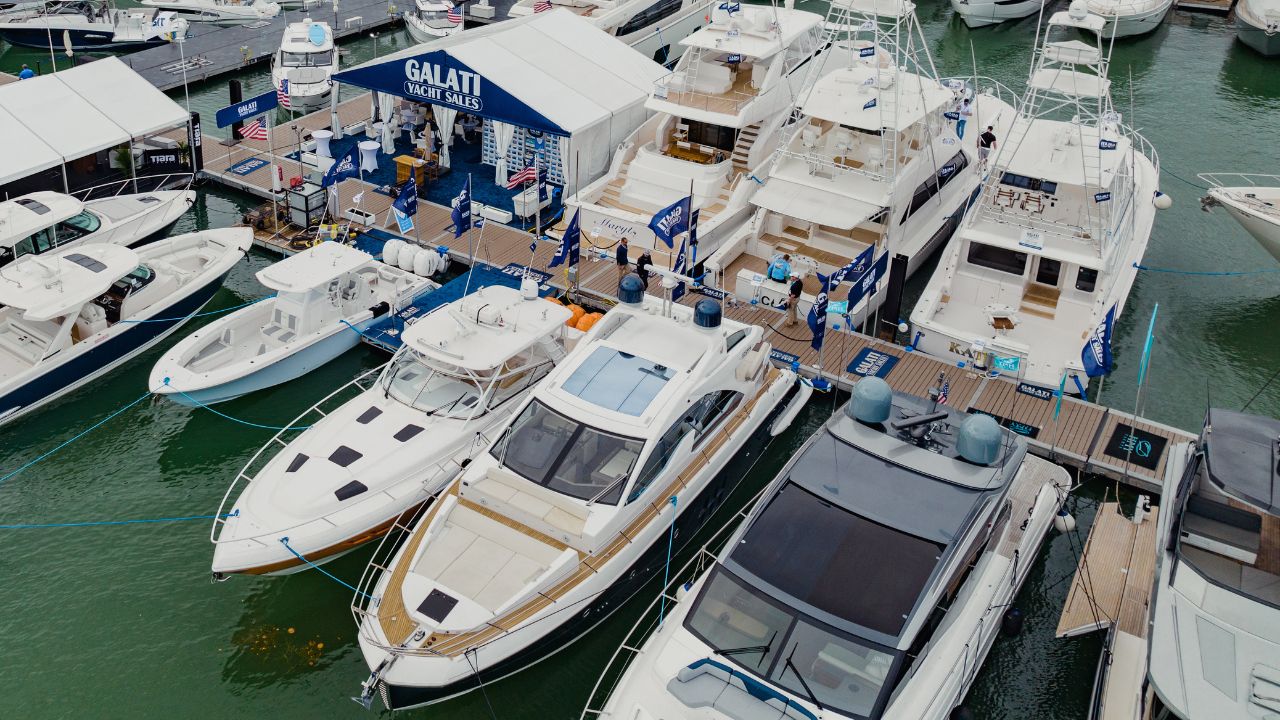
Storage in Different Parts of the Boat
Rail and Head Storage
Rail and head storage is an effective way to utilize the often underutilized space in the rail and head areas of the boat. Items such as lifebuoys, fishing nets, and life jackets can be hung on the rails, while smaller items like toiletries and towels can be kept in storage compartments in the head area. Proper organization and storage of these items not only saves space but also ensures accessibility in times of need.
Cockpit and Galley Storage
The cockpit and galley are two significant areas on a boat, where proper storage is essential for convenience and safety. In the cockpit, it is important to store items such as navigation equipment, tools, and spare parts in waterproof compartments. For the galley, it is crucial to have the right storage solutions for food, utensils, and cookware. Effective galley storage ideas include sliding shelves, stackable containers, and hanging racks for pots and pans.
Storage in Closets
To ensure efficient utilization of space, boat closets should be organized and decluttered regularly. Items should be neatly folded and grouped by category (e.g., clothes, linens, or cleaning supplies). Installing shelves or racks inside closets can maximize the available storage capacity and facilitate easy access to stored items.
Storage Using Velcro and Bins
One innovative way to optimize storage on a boat is by using Velcro strips and storage bins. Velcro can be used to attach items, such as flashlights and small tools, to walls or ceilings, freeing up valuable space. Storage bins, on the other hand, can be used to organize and categorize items while keeping them secure during rough sea conditions. They can be stacked, making them a space-efficient storage solution.
In conclusion, proper organization and creative storage solutions are essential for maximizing space and maintaining a safe and comfortable environment on a boat. Using these various storage methods in different parts of the boat will ensure optimal use of space, functionality, and convenience.
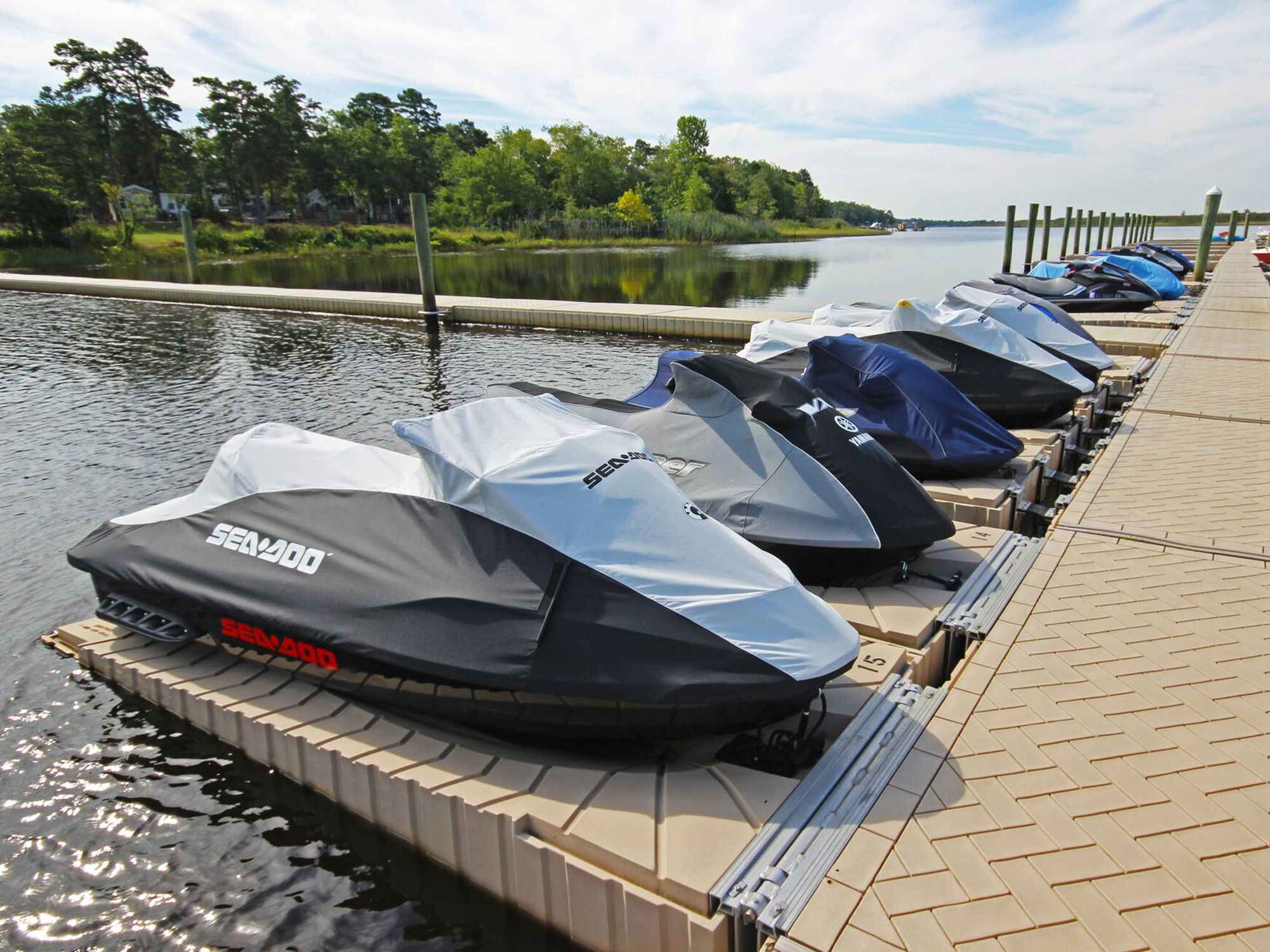
Preserving Items During Boat Storage
Clothing Storage
Storing clothing on a boat requires careful consideration to prevent mildew and musty odors resulting from dampness. To preserve the clothing, use airtight, waterproof containers or vacuum sealed bags to store them. It is crucial to store clothes in dry, well-ventilated areas to discourage mold growth. Ensure that the storage areas are regularly cleaned and inspected for any leaks, especially during the rainy season.
Vegetable Storage
Proper vegetable storage is essential for maintaining freshness on a boat. To prolong the life of vegetables, keep them in a cool, dry, and well-ventilated area. Utilize mesh produce bags or a hanging produce storage system, which allows air to circulate around the vegetables, reducing spoilage. It is also recommended to keep vegetables away from direct sunlight and separate ethylene-producing fruits to avoid hastening the ripening process.
Hammocks
Hammocks serve as a functional and space-saving solution for boat storage. They can be used to store a variety of items, including clothing, shoes, and even food items. To make the best use of hammocks, attach them to sturdy hooks or cleats, ensuring that the contents are secure even in rough waters. Regularly check the hammocks for wear and tear and replace them as needed to maintain their efficacy in storing items.
Tackle Boxes
Tackle boxes are ideal for organizing and storing small items, such as fishing gear, tools, and hardware. Select tackle boxes with adjustable compartments and waterproof seals to protect the contents from moisture and corrosion. Place the tackle boxes in easily accessible areas, and secure them with bungee cords or straps to prevent movement during navigation. Proper tackle box maintenance involves routinely inspecting and cleaning the compartments, as well as replacing worn-out or damaged sections.
Storage Bags Storage
Investing in durable, water-resistant storage bags is highly recommended for boat storage. These bags can be used to store various items, including personal belongings, electronics, and documents. Opt for bags with secure zippers or roll-top closures and ensure that the seams are well-sealed to protect the contents from moisture. As with other boat storage solutions, it is essential to regularly check the bags for any signs of wear and replace them when necessary to guarantee their efficacy in preserving items.

Materials for Boat Storage
When it comes to boat storage, choosing the right materials can make a significant difference in the protection and longevity of your investment. In this section, we will discuss two popular materials for boat storage: canvas and silicon.
Canvas for Boat Storage
Canvas is a widely used material for boat storage due to its durability, water resistance, and breathability. It can be made from natural fibers, such as cotton or linen, or synthetic fibers like polyester or acrylic. Canvas covers are designed to protect boats from environmental factors like rain, UV rays, and debris. They are relatively lightweight, easy to handle, and can be customized to fit individual boat shapes and sizes.
One advantage of canvas covers is their ability to allow air circulation, preventing moisture buildup and mildew growth. This is important for the overall health of your boat as trapped moisture can lead to wood rot and corrosion. However, it's essential to choose a high-quality canvas cover with reinforced seams and proper stitching to ensure maximum protection.
Silicon for Boat Storage
Silicon is another material commonly used in boat storage, specifically in the form of sealants and coatings. Silicon-based sealants provide an effective waterproof barrier between your boat's surfaces and the harsh marine environment. This helps prevent water damage, leaks, and corrosion, which are some of the primary causes of boat deterioration.
Additionally, silicon coatings can be applied to various parts of your boat, including the hull, deck, and fittings. These coatings not only protect against water damage but also provide resistance to UV rays, reducing the risk of fading and discoloration. Silicon-based products are known for their long-lasting durability, minimal maintenance requirements, and resistance to harsh chemicals.
When selecting materials for boat storage, it's important to consider their specific properties and how they would best suit your needs. Canvas and silicon both offer benefits in terms of protection, durability, and maintenance, making them popular choices for boat owners. Remember to invest in high-quality products and apply them correctly to ensure the best results in preserving your boat's condition and value.

Measuring for Boat Storage
When planning for storage on a boat, it is essential to accurately measure the available space and consider the most efficient ways to utilize it. Organizing your boat will help you keep the items you need at hand and make the most of the limited space on board. This section will discuss measuring for boat storage and the importance of using measuring cups for efficient storage.
Measuring Cups for Storage
Measuring cups are a handy and essential tool for any boat owner looking to optimize their storage space. They offer a clear and simple way to measure the volume of items, making it easy to organize and stow away items in a way that maximizes the available space.
- Material: Measuring cups can be made from different materials, such as plastic, stainless steel, or silicone. Be sure to choose a material that is durable and resistant to wear and tear, especially when used in a marine environment.
- Sizes: They typically come in a range of sizes, including 1/8 teaspoon, 1/4 teaspoon, 1/2 teaspoon, 1 teaspoon, and 1 tablespoon for dry measurements, and 1/4 cup, 1/3 cup, 1/2 cup, and 1 cup for liquid measurements. These varying sizes make it easy to measure and store items with precision.
- Stackable Design: Many measuring cups are designed with nesting or stackability features. This allows for easy storage and helps save space, as they can be conveniently stored in a single stack rather than taking up multiple compartments.
In conclusion, measuring cups are an excellent tool for boat storage optimization. Their multiple sizes, durable materials, and stackable designs make them ideal for quickly and accurately assessing the volume of items to be stored and for keeping your boat tidy and organized.

Recommendations for Boat Storage
Boat storage can be a challenge, especially if you want to find a suitable and convenient place to keep your vessel safe and well-maintained. To help you navigate this process, we will discuss some common considerations for boat storage and offer suggestions on adhering to Homeowners Association Rules and other storage options.
Homeowners Association Rules
When storing your boat at home, it is essential to understand and comply with your homeowners association (HOA) rules. Each HOA has its own set of regulations, which may include:
- Location: Some HOAs require boats to be stored in specific areas, such as side yards or behind the house. Always confirm the permitted location for boat storage with your HOA.
- Screening: Your HOA may require boats to be concealed with landscaping, fencing, or other screening materials to maintain neighborhood aesthetics.
- Size restrictions: There may be limitations on the size of boats or trailers that can be stored on your property. Be sure to verify size allowances with your HOA.
It is crucial to consult your HOA's governing documents or speak with a board member if you are uncertain about the rules and restrictions for boat storage in your community. Additionally, maintaining open communication with your neighbors can help you avoid any potential conflicts.
Storage Options
Aside from adhering to HOA regulations, it is essential to consider various storage options to ensure your boat's safety and preservation:
- Dry storage facilities: Dry storage facilities offer indoor or outdoor spaces tailored for boat storage. These facilities typically provide security and, in some cases, maintenance services. They are an excellent option for boat owners who cannot keep their boats at home due to HOA restrictions or space limitations.
- Marina slip rentals: Renting a slip at a marina can be a convenient option for boat owners who want easy access to their vessels. Boat owners can ensure their boats are secure and vulnerable to weather or theft. Do thorough research on marina slip rental fees and amenities before making a commitment.
- Rack storage: For smaller boats, rack storage facilities are an efficient and cost-effective solution. These facilities securely store boats on large racks, protecting them from the elements.
In conclusion, understanding your HOA regulations and available storage options will help you make the best decision for your boat's care and maintenance. Remember to communicate with your HOA and neighbors, and consider professional storage facilities if necessary.

Frequently Asked Questions
How can I maximize space on my fishing boat?
To maximize space on your fishing boat, consider decluttering and organizing your fishing gear, tackle, and personal items. Use storage containers, tackle boxes, and organizers for smaller items. Make efficient use of your boat's built-in storage compartments and think vertically by using overhead storage racks, rod holders, and hanging mesh bags.
What are some interior boat storage ideas?
Some interior boat storage ideas include utilizing under-seat compartments, installing custom shelving or cabinets, and adding hanging storage. Consider collapsible, stackable, or modular storage options for versatility and better space management. Use clear plastic containers with labels to make it easy to find what you need quickly.
How do you create DIY storage compartments?
Creating DIY storage compartments can be a cost-effective way to increase storage without compromising on the boat's design. You can use heavy-duty plastic storage bins, waterproof boxes, or even repurposed household items as storage containers. Additionally, consider building custom shelves, cubbies, or hinged lids on your existing benches to create hidden storage spaces. Don't forget to add cushioning or anti-slip materials inside the compartments to protect your items.
What are some small boat storage solutions?
Small boat storage solutions often involve maximizing the use of every available inch. Focus on utilizing vertical space, as well as under seats, floor hatches, and gunnel compartments. Look into collapsible or folding gear, such as chairs or tables, that can be easily stored when not in use. Also, consider installing additional hooks, clips, or bungee cords to hold items in place and prevent them from rolling around.
What is the proper term for storage on a boat?
The proper term for storage on a boat is "stowage." Stowage refers to the dedicated spaces or compartments for storing items such as equipment, supplies, and personal belongings on a vessel.
How much does boat storage typically cost monthly?
Boat storage costs can vary depending on the location, type of storage, and size of the boat. For example, indoor dry storage facilities may cost between $100 to $900 per month, while outdoor storage can range from $25 to $300 per month. On the other hand, storage in a marina with a wet slip could range from $150 to $1,000 per month or more, depending on the marina's location and amenities. It's essential to research and compare prices in your area to find the best option for your needs.
Charlie is Editor-in-Chief of Sea Magazine
